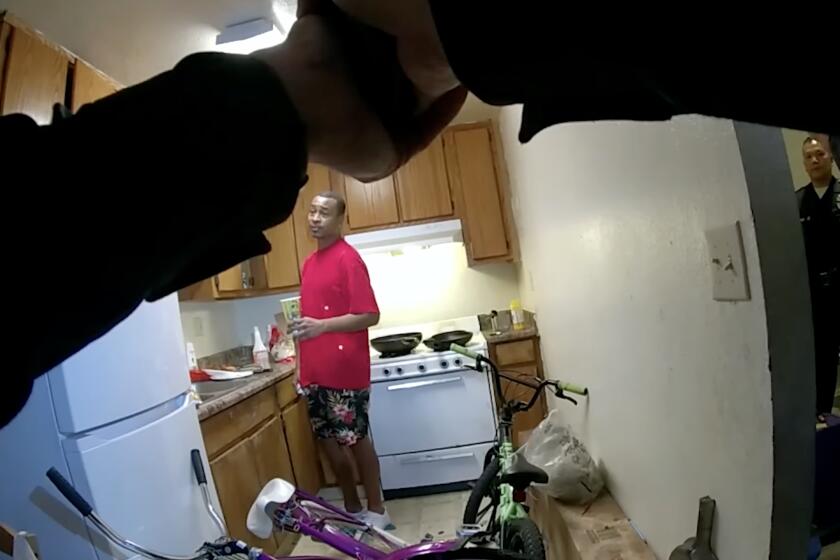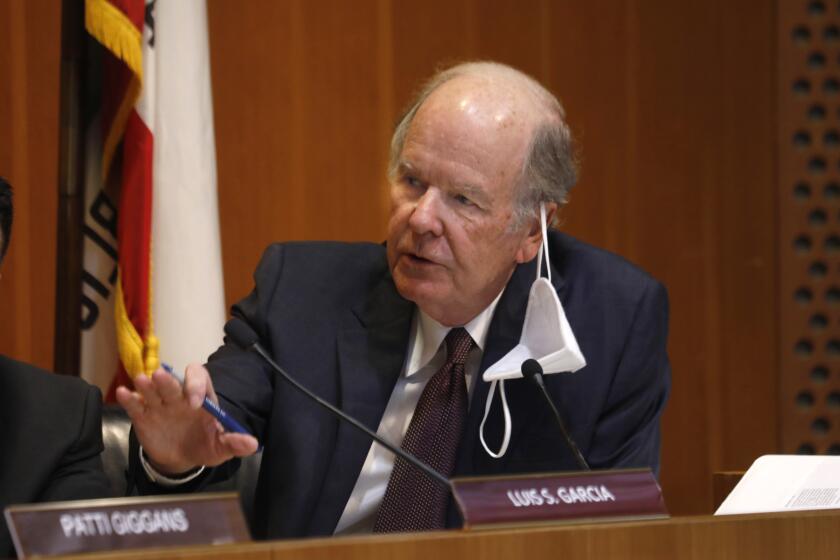Police Commission rules LAPD shooting of mentally ill man was not justified

- Share via
Two Los Angeles police officers violated department rules on lethal force by shooting and killing a schizophrenic man who barricaded himself in a cramped kitchen as officers ordered him to drop his knife, the LAPD’s civilian Police Commission ruled Tuesday.
The decision marked the second time in recent weeks the commission found that city officers were not facing an imminent threat when they used force against someone in the throes of a mental health crisis.
Furthermore, officials concluded that the officers’ attempts in January to coax Takar Smith out of the kitchen were undermined by a combination of poor planning, questionable tactics and a disregard for protocols that direct officers to summon the department’s mental health unit for such occasions.
The incident came after Smith’s wife, Shameka, called police on Jan. 2 to report her husband had violated a restraining order by showing up at her apartment, where he grew violent.
Several Los Angeles police officers broke department policy when they grappled with and used a stun gun on Keenan Anderson, the Police Commission ruled Tuesday.
She mentioned several times that he hadn’t been taking his medication to treat schizophrenia, but the information wasn’t relayed over a radio transmission dispatching officers to the scene. Rather, a dispatcher informed the responding officers that Smith said he intended to fight police.
By a 4-0 tally, the commission agreed with Chief Michel Moore’s findings that officers Joseph Zizzo and Nicolas Alejandre acted inappropriately when they fired a combined seven rounds at Smith, who used a pair of bikes to create a barrier between himself and police as he stood in the kitchen, holding a knife.
After officers shocked Smith several times with a Taser, he was knocked to his knees and lost control of the blade; officers opened fire when he picked up the knife again.
Moore agreed with an internal force review board that said Alejandre and his police partner, Audrey Lopez Alonzo, had “sufficient time to contact” the Mental Evaluation Unit, or MEU, which pairs officers with county social workers trained in de-escalating standoffs with people thought to be mentally ill.
Lopez Alonzo was a probationary officer at the time of the incident. Neither she nor Alejandre considered contacting the MEU, Moore said, nor did they relay information about Smith’s history of schizophrenia to the other responding officers, including Zizzo.
The layout of the small, cluttered apartment posed several tactical disadvantages for officers, according to the report. For one thing, they had little space to maneuver and find better cover, Moore wrote in the report. Still, Moore said he would’ve liked the officers to retreat, even briefly, so they could reevaluate the situation and come up with a better plan of action.
What punishment the officers will receive, if any, falls to Moore.
Smith’s death came amid a string of fatal police encounters to start the year, which set off protests and prompted Mayor Karen Bass to voice her “grave concerns” after watching body camera video of the encounters.
Last month, the commission concluded that officers involved in one of those deaths broke from department policy on multiple occasions. In that incident, Keenan Anderson, a school teacher and cousin of Black Lives Matter Global Network co-founder Patrisse Cullors, died several hours after an officer stunned him repeatedly with a Taser after a traffic accident.
As with Anderson’s case, Smith’s death was held up by mental health practitioners and critics of the department as proof that officers are ill-equipped to make the right decisions when confronting people in distress. Days after Smith was shot, Moore took the unusual step of publicly second-guessing the officers’ actions, telling reporters at a news conference that he worried about the “actions of our officers and supervisors.”
LAPD Chief Michel Moore addressed the three deaths at Tuesday’s meeting of the Police Commission, promising to make public body-camera footage the following day.
Some of those concerns were reflected in his report about the incident, released Tuesday, which synthesized the findings of a months-long investigation of the incident.
In an interview after the shooting, Alejandre told department investigators he felt that even while on his knees Smith could still cause him harm because of his 6’1” height. “The stabbing motion to me appeared that it could reach me,” said Alejandre, who is 5’4”, according to the chief’s report.
No officers were injured in the incident.
Relatives said Smith, a father of six, had been on medication the last several years to treat schizophrenia. But, his wife and others said, his mental health had been worsening, which had strained the couple’s relationship.
On the day of the shooting, Smith became enraged and started throwing things around the apartment. When he refused to leave, Shameka Smith walked into the nearby Rampart police station and told an officer at the front desk that her husband had violated a restraining order.
The officer gave her the number for the department’s nonemergency dispatch and advised her to return to the apartment and wait for police there, the chief’s report said. Moore said the officer’s actions are the subject of an internal investigation.
A few hours later, a group of officers showed up and instructed her to wait outside while they checked on her husband, Shameka Smith said. In an exchange that was captured on Alejandre’s body-worn camera, she warned him that her husband had threatened to fight police if they were called and that there was a knife in the kitchen. But she also relayed that he had been diagnosed with schizophrenia and implored them not to kill him.
Inside, the officers confronted Smith, engaging in a tense back-and-forth with the incoherent man.
Both Alejandre and Zizzo fired their Tasers at Smith after he picked up a kitchen knife and wouldn’t drop it; but the electrified barbs didn’t appear to have any effect on Smith, who pulled them out of his skin. Another officer deployed pepper spray. At one point, Smith fell to the ground and dropped the knife, but picked it up.
The standoff ended when the officers opened fire, killing Smith as he knelt on the kitchen floor holding a knife. Alejandre shot twice, while Zizzo fired five rounds.
Smith’s family filed a wrongful death lawsuit against the city in July, alleging that the involved officers unnecessarily escalated the encounters while contending that “there were other reasonable alternatives to using deadly force against (Smith) which were available and not utilized prior to using deadly force.” The suit is pending.
Shootings by Los Angeles police officers dropped in 2022, although a larger share of those encounters turned deadly, according to preliminary data released by the Police Department.
In recent years, the LAPD and other law enforcement agencies nationwide have faced increasing criticism for how often officers shot people in the throes of a mental health crisis. LAPD data show that 35% of the people shot at in 2022 were showing obvious signs of mental distress, a 6% decrease from the year before.
Moore has expressed support for partnering officers with mental health workers but has maintained that incidents involving armed suspects require some sort of police response. Understaffing at the county has resulted in gaps of coverage by the mental health co-responder teams, Moore has previously said.
Several of Smith’s relatives attended the Nov. 14 meeting of the Police Commission, giving emotional testimony, calling for the officers involved to be held accountable and describing how his death had left a huge hole in their lives that they could never hope to fill.
His cousin, Daphne White, said his death had devastated Smith’s mother, who had suffered two mini-strokes that family members think may have been from the pain and stress of losing her son so suddenly. She has been given to long bouts of crying since the incident, White said. “She misses her baby.”
White wondered why the officers hadn’t called a mental health unit upon recognizing they were dealing with someone who wasn’t in his right mind, and may not have understood what was happening.
“They could’ve handled it way differently. I mean he wasn’t charging them,” she told a reporter before the meeting.
Raischard Smith, Smith’s brother, wore a gray hoodie and held a photo of Smith.
“They didn’t go through the right procedures. If they’d gone through the right procedures we wouldn’t be here,” he said. “We want justice. They keep killing us and getting away with it.”
More to Read
Sign up for Essential California
The most important California stories and recommendations in your inbox every morning.
You may occasionally receive promotional content from the Los Angeles Times.

















